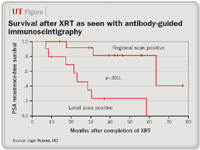Article
Puzzling XRT results found with immunoscintigraphy
Honolulu--Men with local-regional prostate cancer following radical prostatectomy appear to have a more durable response to subsequent salvage radiotherapy than those patients with fossa-only or no disease following the operation, a new study shows. This finding is in direct contrast to what would normally be expected, said Inger Rosner, MD, a resident at Walter Reed Army Medical Center, Washington, working with David G. McLeod, MD.

Dr. Rosner set out to collect data on the role antibody-guided immunoscintigraphy imaging with indium-111-capromab pendetide (ProstaScint, Cytogen Corp., Princeton, NJ) might play in predicting responses to salvage radiotherapy following prostatectomy. What Dr. Rosner and colleagues found was not what they expected, she said.
"We expected that the individuals who had local uptake on the ProstaScint would fare better with salvage radiation treatment. The thought was that they have no disease outside the prostate, and they should respond better to what is considered definitive treatment," Dr. Rosner told Urology Times.

"This is contradictory to our original premise that patients who had fossa-only uptake on the ProstaScint would have a better response to salvage radiation. We were surprised by this finding," Dr. Rosner said during a presentation at the annual Kimbrough Urological Seminar.
"Men who had regional uptake were more likely to have larger field radiation to their pelvis. This may offer better biochemical control. Why is that? We don't know. Perhaps this radiation is better in this situation than we think."
The median preoperative PSA in these patients was 7.4 ng/mL (range, 0.5 to 50.0 ng/mL). The median Gleason sum at biopsy was 6 (range, 5 to 10). Eight patients had pT2 pathologic disease, and 17 had pT3 disease. Of the 25 patients, two had non-diagnostic scans, 10 had uptake limited to the prostatic fossa, and 13 had regional uptake.
Eleven (84%) of the 13 men who had regional uptake showed a durable biochemical response at a median follow-up of 30 months, compared with only two (20%) of the 10 with localized uptake. The scan results were stratified by pathologic T-stage and surgical margin status, but no statistical significance was found.
"We generated Kaplan-Meier curves that compared those with positive regional scans and those who had positive local scans," Dr. Rosner said. "The patients who had positive regional scans had a significantly increased PSA recurrence-free survival, with a p-value of .001.
"Additionally these patients were more likely to receive more extensive radiation fields," she said.
Dr. Rosner said the study is expanding and continuing. The investigators intend to add computed tomography cross-sectional imaging to acquire additional data.
"One of the problems radiation oncologists face is that they do not have definitive treatment protocols based on ProstaScint results. If they have a patient with regional uptake, do they treat with whole-pelvis radiation up to the border of L5-S1, or do they treat only up to the SI joint? What field radiation are they supposed to offer? It is not like following a cookbook," she said.
According to Dr. Rosner, the ideal study on this issue would be a prospective study combining CT and ProstaScint, which would confirm the effects of salvage radiation therapies in local and regional disease.
















